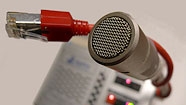European Broadcast Union sets standard for broadcast intercom

The European Broadcast Union (EBU) has published specifications for interoperable intercom over IP, preparing the ground for a new era of multivendor IP devices in the field. This will save time and money for broadcasters, who currently have to implement and support a variety of interfaces to communicate between multiple locations or adopt a single vendor’s intercom systems, which is not always possible. Interoperable intercom will also make it easier for broadcasters to communicate with each other during big multinational events such as the Eurovision Song Contest, which is run by the EBU. As such, intercom needs to be dedicated to the task, which is why the public telephone network has not been used and research has led to the evolution of various schemes for private communication between small numbers of participants.
As broadcast contribution and distribution has been migrating toward IP, there has been growing pressure from broadcasters to move intercom to IP as well. As often, the EBU has been a prime mover, first by publishing its Audio Contribution over IP (ACIP) Requirements for Interoperability in its EBU Tech 3326 document in 2007. This provided the technical basis for the EBU Tech 3347 intercom-over-IP specifications, which are now available for manufacturers first to incorporate in their products for interoperability tests, which the EBU says may be held later in 2011.
Both the ACIP and the intercom-over-IP standards make use of technology already well proven in IP telephony and data communications, in particular Session Initiation Protocol (SIP), an Internet Engineering Task Force (IETF) signaling protocol for setting up, modifying and terminating voice or video sessions involving two or more participants on an IP network. SIP delivers the fast setup and low latency needed for interactive voice communications and has been widely applied over both the Internet and telephony IP networks to support VoIP services. The additional requirement for audio contribution and, subsequently, intercom is support for high-quality audio, and this has been added by the EBU with extensions using existing codecs, including MPEG-2 and MPEG-4.
It is true that intercom itself does not require the same quality as audio contribution and will continue to operate at lower bit rates, much like VoIP, but it makes sense to align it with audio contribution over IP so the same network can be used, allowing the intercom devices to interoperate with the codec. There is also then scope for applications that integrate contribution with intercom for material exchange during broadcast.
The EBU started the ball rolling for intercom over IP at IBC2009 with a meeting of leading manufacturers in the field, leading to publication of draft specifications at IBC2010 and final requirements in February 2011.
The professional video industry's #1 source for news, trends and product and tech information. Sign up below.
